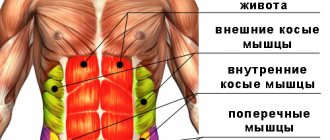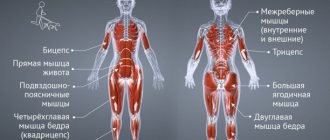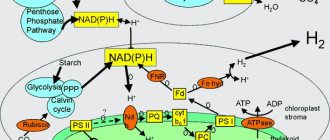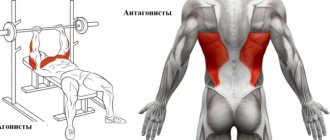Many people choose running as a way to stay fit and healthy. This is a really useful exercise that helps keep the body in good shape and promotes beautiful and uniform weight loss. But running also has its side effects, so to speak. For example, many people are interested in why their side hurts when running. This question is complex, and it can have a lot of reasons, so it’s worth familiarizing yourself with them all and understanding what is relevant specifically in your case.
Improper breathing
Insufficient saturation of the diaphragm with oxygen - this theory has long been the only explanation for why the right side hurts during running, as well as after it.
The bottom line is that during running the diaphragm works more actively, its need for saturation with blood and oxygen increases. More of them are required by other muscles involved in motor activity. Due to frequent, confused breathing, the functioning of the diaphragm is disrupted, as a result, the heart also does not receive enough blood, which provokes pain. After a forced stop, the diaphragm does not immediately return to its previous state, and my right side still hurts for some time after running. After the normal breathing rhythm is restored, the pain subsides.
This theory causes a lot of controversy, since some people experience pain not in the right side when running, but in the lower abdomen, where there is no diaphragm. In addition, it is very resilient - the continuous process of breathing trains this muscle area well.
Preventing side pain when running
It is best to prevent pain by making the workout as comfortable and enjoyable as possible. To prevent side pain when running, consider the following:
- There should be at least two hours between eating and running. Before exercise, you should also not drink a lot of liquid - this can also cause discomfort in the side.
- Be sure to warm up. Every workout should start with this. This will warm up the muscles and promote uniform circulation of blood, that is, it will improve its circulation without overfilling the internal organs.
- If you run to lose weight, do not torture your body . Choose the optimal, comfortable pace for yourself. This is especially important for beginners.
- Breathe deeply while jogging. This will increase the amplitude of the diaphragm and improve blood flow to the heart and other vital organs.
Painful sensations when running in most cases indicate that you do not know how to distribute the load or that you are violating the rules of running. But in some cases they can signal health problems. It is important to learn to listen to your body and, if necessary, contact a professional.
Frequent alcohol consumption
We are not talking about professional athletes, but about people who do not always adhere to a healthy lifestyle.
When drinking alcoholic beverages, the liver experiences enormous stress. The result is an increase in size and pressure on the nerve endings. If an “athlete” has a bad habit, pain in the right hypochondrium will become a regular occurrence.
Massage your side as you exhale
Sergey Sorokin, co-founder and head coach of the Jaxtor marathon club:
The liver has no nerve endings, so the liver does not hurt. When a lot of blood enters this organ and less comes out, the liver enlarges and begins to put pressure on those places where nerve endings are present. For example, the fascia (sheath) of the liver has a mass of nerve endings, and when the liver becomes enlarged, painful sensations occur.
To stop the pain in your side, you need to take a deep breath and, while exhaling strongly, thoroughly massage the liver area with strong pressure. By doing this, you stimulate blood flow and the pain will go away.
On the eve of the start, avoid eating fatty, fried foods, because... it overloads the liver, which needs to process lactic acid during running.
Insufficient muscle preparation
If you don’t do a good warm-up before running, your body will experience stress. In a calm state, blood circulation and oxygen saturation of all body systems are established. Without preliminary preparation of the body for physical activity, normal blood circulation and oxygen delivery are disrupted. The spleen and liver immediately react to this - having increased in size, they compress the nerve endings.
Pain in the side when running: symptoms
Knowing why side pain occurs when running, you also need to consider the symptoms that indicate that the discomfort will soon make itself felt.
Depending on the characteristics of the pain and the conditions in which it appears, the following symptoms are distinguished:
- Weak endurance of the body, high loads, lack of warm-up or improper warm-up, lack of preparation for physical activity.
- Breathing problems (if you have difficulty breathing when running, your breathing becomes intermittent and uneven).
- Recent pre-run food intake.
- Chronic diseases that make themselves felt during physical activity.
Pain occurs not only among those who have just started running or are overweight. This also happens among professional athletes who are accustomed to prolonged exercise.
Before physical activity, you drank juice or soda
There is a small volume of fluid in the human intestine (its scientific name is intraperitoneal). It is located between the parts of the membrane covering the abdominal cavity, this prevents them from rubbing against each other. Juices, carbonated and energy drinks significantly change the composition of the liquid, reducing its amount. If pain occurs after consuming them, this is the answer to the question of why the right side hurts when running.
Before physical activity, as well as during it, it is recommended to drink only clean water without gas; it does not affect the fluid in the intestines.
How to run correctly so as not to get sick
- Before running, you definitely need to develop your diaphragm by drawing in and inflating your stomach . Take a few deep breaths.
- You need to run smoothly, do not stomp, shift the center of gravity forward. You can sway slightly. When running, it is necessary to maintain uniformity of both breathing and the rhythm of steps.
This does not mean that you need to breathe slowly, no, the main thing is that the breaths are taken at approximately the same frequency and with approximately the same amount of air .
- In addition, you need to slow down the pace of your workout or stop altogether, exhale slowly and gradually and calm your breathing, while placing your hand on the site of pain and lightly massaging the muscles .
- If possible, bend over and touch your toes and stand in this position for a few seconds. Then straighten up and stretch up, as if trying to “touch the sky” with your fingers, while inhaling, then lower your hands again and reach down to your feet as you exhale.
- Drink some water.
There is another interesting point in international studies of sports medicine. It turned out that pain most often occurs on the side of the leg on which you land when exhaling . For example, if you exhale, landing on your right leg, the pain occurs in the right hypochondrium, and if you exhale on the left, then in the left.
Therefore, try to practice synchronizing your exhalation with landing on the opposite leg, this usually helps eliminate attacks of lateral cramp.
If it is truly a normal sports cramp, the pain will go away quickly. But you need to remember about some serious diseases that can masquerade as this symptom:
- If pain in the left hypochondrium, despite all the measures taken, persists and spreads along the left arm and shoulder, this may be a symptom of hidden angina .
- Persistent or increasing pain in the right hypochondrium or right iliac region is a sign of appendicitis .
- If the pain arose in the side, but began to radiate to the groin and back, it is quite possible that renal colic .
- If pain becomes more frequent during training and begins to appear at rest, this is a reason to consult a doctor, just as in all the situations described above, do not neglect this advice!
Why does my right side hurt after running? Ways to eliminate pain
The causes of pain in the right side after running are the same as during it. After some time after stopping, the pain should subside.
If this happens too slowly, you need to use one of the ways to speed up the process:
- Start walking, taking deep breaths. You need to try to make sure that the foot hits the ground or floor on the left side at the same time as you exhale. It is not necessary to do this for each touch of the running surface of the left leg; you can exhale after 1-2 steps. The painful sensation is relieved due to the fact that the left side begins to take the main load, allowing the muscles of the right side to relax.
- Make forward inclined movements, thanks to them the tension in the abdominal region is relieved.
- Perform a stretching exercise: raise your left arm up and bend to the right, then raise your right arm and bend to the left. Movements should be slow and smooth; it is recommended to linger for half a minute at the maximum point of inclination.
- Rub the diaphragm.
- Perform breathing exercises: inhale deeply, then, curling your lips into a tube, exhale for a long time. Repeat several times. In this way, the tense diaphragm is massaged from the inside.
- Bend forward, touching your palms to your toes.
- Massage the painful area with three fingers of your right hand; you can simply press on it until the pain subsides.
- Pull your stomach in as far as possible, taking strong inhalations and exhalations through your nose.
Pain in the side after running
Pain after running often occurs for the same reasons as during jogging. Quite often the factor of sudden cessation of jogging plays a role, that is, excessive load and sudden stop. You shouldn't test your body this way. As you plan to finish your workout, gradually transition to a slower run or faster walk.
If discomfort while running still makes itself felt, follow these recommendations:
- Take a deep breath, relax your muscles and calm your breathing. It is important to try to relax your entire body.
- If you feel pain in your side, experts recommend pressing your fingers on the area causing discomfort and remaining in this position until the pain goes away.
- If this does not help, gently massage the side and allow the liver or spleen to relax.
- Inhale deeply and exhale as slowly as possible through pursed lips.
If you experience pain after running due to low fitness, try replacing running with brisk walking first. This way you will prepare your body, and over time it will not feel discomfort even during active exercise. Remember that everything should be gradual.
How to reduce the likelihood of pain when running
Running is one of the best ways to improve your overall health; it can help you easily lose weight and improve your well-being.
To prevent the process from causing discomfort and pain, you need to properly prepare for it, and also follow a number of rules while running:
- If you are determined to take up running, you need to reconsider your lifestyle. It is not recommended to overwork too much; rest should be complete.
- You need to go for a run during hours of maximum relaxation. Psychological stress, fatigue, desire to get enough sleep, etc. will manifest themselves even more strongly after running.
- If you are jogging in the morning, you need to give your body time to wake up (about half an hour). If you start running immediately after waking up, your body will experience stress and your metabolism will be disrupted. If jogging in the evening, the muscles should rest after a hard day for a couple of hours, this will help avoid overwork.
- You need to organize a proper diet. Any snack before running increases the likelihood of pain in the right side to almost 100%.
- It is important to monitor the quality of food consumed. Even if the time frame is respected, pain will arise due to junk food; fatty foods simply will not have time to be digested in the prescribed time.
- If diseases of internal organs and systems are excluded, and pain in the right side is regular, it is recommended to wear an elastic belt on the stomach before jogging. When pain occurs, it needs to be tightened as tightly as possible.
- You should not run to the point of exhaustion, exhaustion of the body will not bring the desired result.
- At the beginning of the process, you need to immediately set the optimal running pace. It is a mistake to believe that the faster the better - everyone’s physical fitness is individual. A poorly prepared person will begin to choke from too fast a pace in the first minutes.
- It is important to learn how to breathe correctly. Swimming athletes are a good example. They can breathe only at the moment when their face is above the surface of the water, their breathing is synchronous with body movements. Synchronizing inhalations and exhalations with the impact of the legs on the running surface will allow all organs and muscles to be evenly enriched with oxygen, which will significantly reduce the likelihood of pain in the right hypochondrium.
- Training should be regular. The better your endurance and physical fitness, the less often you experience pain in your right side.
- To prevent curvature of the spine from interfering with a full workout, you should always walk with a straight back and head held high.
- Warming up is a must before running; the better the muscles are prepared for further stress, the lower the risk of injury and pain.
- The load should be strictly dosed and increase smoothly. Overestimating your own athletic capabilities will result in stabbing pain in the right hypochondrium.
Running is one of the best sports to improve your health and fitness. To prevent acute pain in the right side from becoming an obstacle to regular training, it is important to reconsider your lifestyle, undergo a medical examination to rule out possible pathologies, and also follow certain rules while running.
Why it stings during time: reasons
The explanations why your right or left side hurts when you run are quite simple:
In right and left
So, why does it sting in the right or left side during or after running? If you feel a stabbing pain while walking or running quickly, then know that if the right side pierces when running, it’s the liver , and if the left side pierces, it’s the spleen .
When the body is not exposed to stress, part of the blood is in reserve and does not circulate through the blood vessels. The main volume of circulating blood occurs in the chest and abdominal cavities.
Physical activity causes a redistribution of blood flow in the body in favor of working muscles. However, it should be noted that unlike muscles, which are ready to start working immediately, the autonomic functions that ensure their work (such as blood circulation and breathing) require some time to “break in.”
When other motivation no longer works










